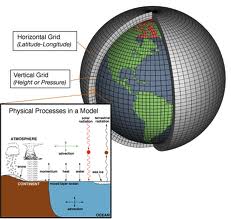*In order to be able to learn more about Earth as a whole, we must be able to look at it as a whole, and be able to see and find areas of particular interest.
*A map is a flat, 2-dimensional representation of Earth’s surface.
–cartographer: mapmaker
–projections: the different ways in which maps can be drawn
-The most common map projection is called the Mercator Projection.
–Positives: shows whole world, except extreme polar regions; shows directions as straight lines
–Negatives: distorts the areas near the poles; omits extreme polar regions
– How do you know the size of the area you’re looking at on a map?
– By using the map scale: tells you how the map’s features compare in size with Earth’s features (either a ratio, picture, or in words).
*Earth is 3-dimensional, thus, maps distort Earth’s features somewhat.
-A Globe is the most accurate model of Earth, but is not convenient! (You can’t put it in your pocket, or use it to find your way across town!)
*We can actually pinpoint locations on Earth, and give each point a unique and unchangeable ‘address’ so that locations are easy to locate!
– Lines of latitude (or parallels) circle the Earth from east to west, and run parallel to the equator
–Equator: the imaginary line dividing the northern and southern hemispheres (hemi= half)
– The equator= 0° latitude
– All other lines of latitude are measured in degrees N or S of the equator.
– North Pole= 90° N
– South Pole= 90° S
-Lines of longitude (or meridians) are half-circles that run from north to south, between the poles.
– Prime Meridian= 0° longitude
– All other lines of longitude are measured in degrees E or W of the Prime Meridian.
*Each degree of latitude or longitude is further divided into 60 minutes ( ΄ ), and each minute into 60 seconds ( ˝ ).
– My home town of Findlay, OH is located at: 41°3΄N, 83°39΄W
Time Zones:
-There are 24 time zones. Why??
-24 hours in a day!
-The Earth’s circumference is 360°.
-Divide 360° by 24 hours in a day= 15° per time zone.
-Time zones are adjusted to accommodate city limits and borders!
